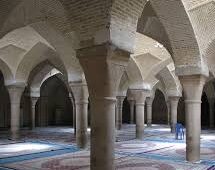Sheikhi Mosque: A Spiritual and Architectural Jewel in Hormozgan
Located in the heart of Hormozgan Province, the Sheikhi Mosque is one of the region’s most captivating landmarks. This mosque not only offers a profound spiritual experience but also serves as a beautiful example of Islamic architecture. Visitors to this mosque are invited to immerse themselves in the rich history and culture of Islamic Iran while appreciating the fine details of its design.
History of the Sheikhi Mosque
The Sheikhi Mosque has deep historical and cultural roots within the Hormozgan region. Its establishment is attributed to the efforts of religious figures and local communities seeking to create a place for worship and reflection. The mosque has undergone various phases of construction and renovation, contributing to its rich architectural style that blends traditional Islamic aesthetics with regional characteristics.
Over the years, the mosque has not only been a site for religious ceremonies but also an important center for the local community. Its presence in the area symbolizes the spiritual heritage of the people of Hormozgan and their connection to the broader Islamic world.
Architectural Features of the Sheikhi Mosque
One of the standout features of the Sheikhi Mosque is its towering minaret and beautiful dome. These elements are characteristic of Islamic architecture, designed to symbolize the mosque’s importance and to make it visible from a distance. The minaret, which rises high above the structure, has a slender and elegant form, serving both a functional and decorative purpose. Historically, minarets like these were used to call people to prayer, and their height was also a sign of the mosque’s significance.
The dome of the Sheikhi Mosque is another striking element of its design. Its shape is typically spherical or semi-spherical, representing the heavens and the infinite. The exterior is adorned with intricate tile work and geometric patterns, common in Persian Islamic architecture. The mosque’s interior is equally impressive, featuring ornate decorations, Islamic calligraphy, and stained glass windows that filter light into the prayer hall, creating an atmosphere of serenity.
The prayer hall of the mosque is spacious and well-lit, with intricate mosaic tiles that adorn the floors and walls. The combination of these design elements gives the mosque a timeless beauty that reflects the spiritual essence of Islam.
Cultural and Spiritual Experience
Visiting the Sheikhi Mosque offers more than just a glimpse into its architectural grandeur. It provides a chance to experience the spiritual atmosphere that the mosque fosters. As one walks through the mosque’s cool courtyards and serene prayer halls, there is a palpable sense of peace and reflection.
The mosque is a place where worshippers gather for daily prayers and special religious ceremonies. It also serves as a community hub for the local people of Hormozgan, providing space for religious teachings and community gatherings. The sense of devotion and tranquility within the mosque makes it a perfect place for those seeking a moment of introspection and spiritual renewal.
Best Time to Visit the Sheikhi Mosque
The best time to visit the Sheikhi Mosque is during the cooler months of autumn and winter, from October to February. The weather during these months is more moderate, allowing visitors to comfortably explore the mosque and its surroundings. During the summer months, the temperatures in Hormozgan can be extremely high, making outdoor activities less comfortable.
If you are interested in experiencing the mosque’s spiritual activities, consider visiting during prayer times or on Fridays for the Jumu’ah (Friday prayer), which is a significant weekly event in Islamic worship.
How to Reach the Sheikhi Mosque
The Sheikhi Mosque is easily accessible from the center of Hormozgan, particularly from the city of Bandar Abbas. Visitors can reach the mosque via taxi or local buses. The mosque’s location is central, making it an ideal stop for those touring the city.
For those interested in a more in-depth visit, many local tour guides offer guided tours of the mosque, providing historical context and detailed explanations of its architecture and significance. Guided tours can enhance the visitor experience, as they offer a deeper understanding of the mosque’s spiritual and cultural importance.
Tips for Visiting the Sheikhi Mosque
- Dress Modestly: As with most Islamic places of worship, visitors are expected to dress modestly. Women should cover their heads, and both men and women should wear loose-fitting clothing that covers their arms and legs.
- Respect the Sacred Space: The mosque is a place of worship, so it’s important to maintain a respectful demeanor. Keep noise to a minimum and avoid taking photos in areas where it is prohibited.
- Check Prayer Times: If you plan to visit during prayer times, check the local prayer schedule to experience the mosque at its most vibrant and spiritual.
- Bring Comfortable Shoes: The mosque’s grounds may involve walking across mosaic tiles and courtyards, so comfortable footwear is advisable.
- Visit During the Off-Season: If you prefer a quieter visit, consider coming during weekdays or the off-season, avoiding weekends when the mosque might be more crowded.
The Sheikhi Mosque in Hormozgan is a testament to the rich history and culture of Islamic architecture in southern Iran. With its impressive minaret and dome, the mosque stands as a symbol of faith, community, and historical significance. Whether you’re an architecture enthusiast, a history buff, or someone seeking a peaceful and spiritual experience, the Sheikhi Mosque offers a unique glimpse into the heart of Hormozgan’s cultural and religious life. Visiting this mosque will undoubtedly enrich your understanding of Islamic heritage and provide a moment of tranquility amid the bustling city.

